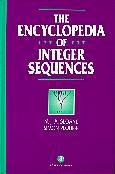What comes next in the sequence 0, 1, 2? How about 720! (720 factorial)? Because 0 = 0, 1! = 1, 2!! = 2, so next comes 3!!! = 6!! = 720!. This little party trick example must be one of the few sequences not listed in this wonderful book (although it does have the sequence n!!).
The Encyclopedia of Integer Sequences is a revised and updated version of the 1973 edition A Handbook of Integer Sequences. It lists over 5000 sequences, in numerical order, each with a brief cryptic description, and a cross-reference to the literature where more information can be found. Most sequences are shown to well over ten terms: given the number of sequences in the book, that many terms can be needed to distinguish different ones! A typical entry is:
From Euclid's proof. Ref GN75. BICA 8 27 93. [0,1; A5265]
Most of these sequences are of genuine mathematical interest (Fibonacci sequence, Catalan numbers, polynomial expansions, primes, continued fractions, to name but a few) or physical interest (magnetisation and susceptibility for square and cubic lattices, atomic weights) -- a few are just for fun (number of letters if written in Roman numerals). There is even a table, Figure M4822, of 'puzzle sequences' that aren't in the main body because they don't satisfy the rules for inclusion: (mostly) infinite integer sequences. The long list of sequences is leavened with the occasional diagram showing a geometrical interpretation of a particular sequence.
If you have generated a few terms of a sequence, and want to see if anything is known about it, then this is the essential reference (or you could try Sloane's On-Line Encyclopedia of Integer Sequences version). Even if you haven't got a particular sequence to track down, but are interested in number patterns, this makes for fascinating (and surprisingly addictive!) browsing.
